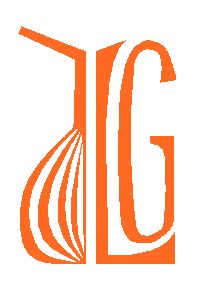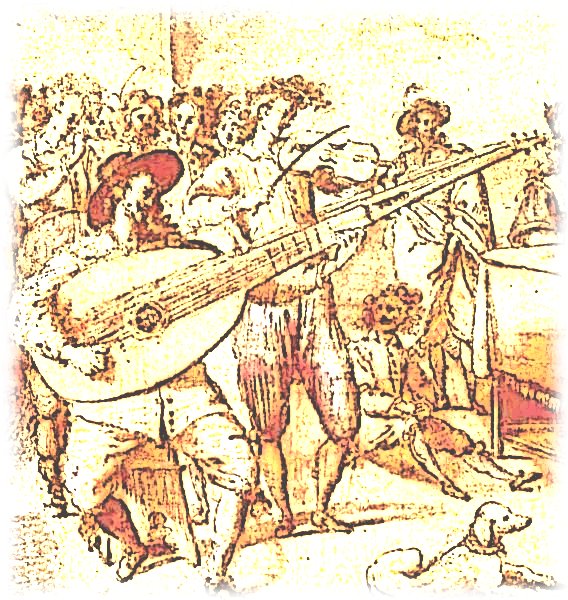Publications of the German Lute Society
| Distribution: | HOLZENBURG VERLAG |
Payment by PayPal is welcome |
YouTube contributions
1st International Conference on Lute Study in Higher Education Bremen 2019
Works for renaissance lute
| Title | Description | Order no. | Euro |
|---|---|---|---|
Brian Wright: Twelve German Christmas Carols 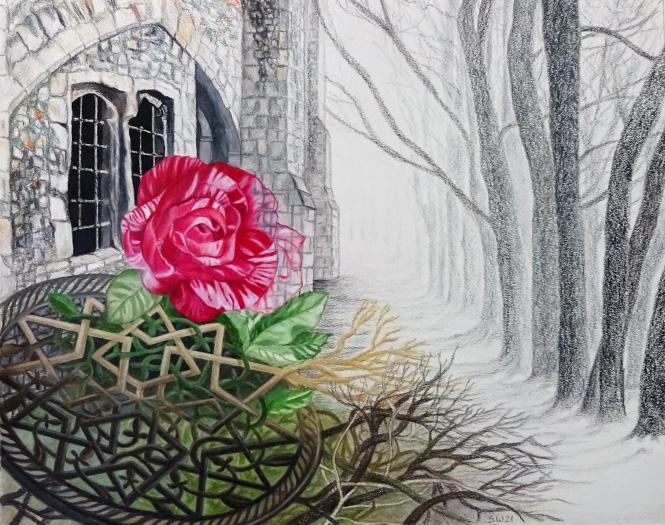
|
The English composer Brian Wright has composed beautiful arrangements for twelve German Christmas carols for voice and Renaissance lute. |
DLG 1370 | 15,- 12,- (DLG member) |
Brian Wright: Fünf Variationen & Fuge über „Kein schöner Land“ 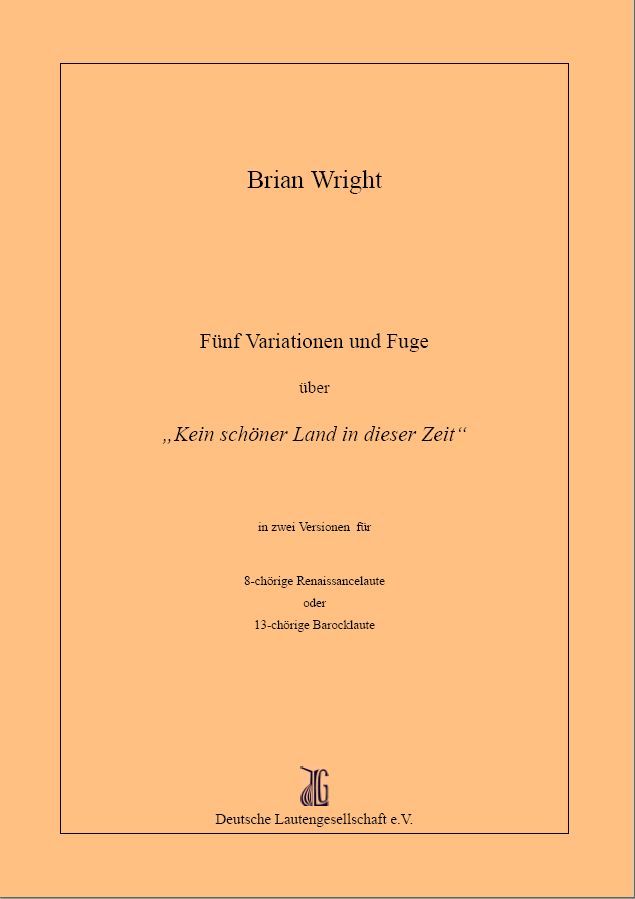
|
The English lutenist and composer Brian Wright wrote this work in 2020 in two versions: Both versions are included in this edition. Everything, Theme, Variations and Fugue, are of medium difficulty, set sonorously and variedly, making use of the whole fingerboard. |
DLG 1350 | 12,- 9,60 (DLG member) |
John Dowland „Von der Fortuna“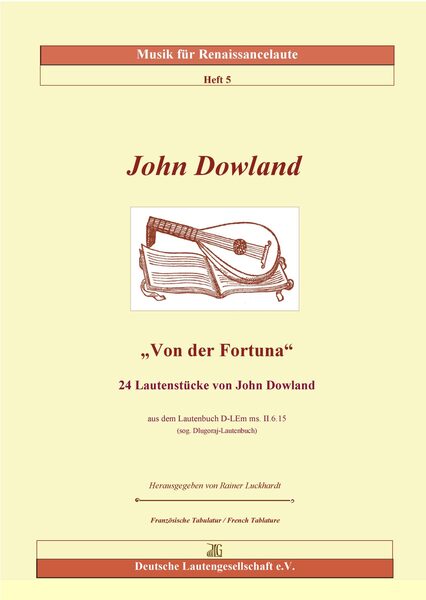
|
24 lute pieces by John Dowland for 8-course Renaissance lute from the Leipzig manuscript D-LEm ms. II.6.15 (so-called Dlugoraj lute book), selected, transcribed into French tablature and edited by Rainer Luckhardt John Dowland travelled throughout Europe throughout his life and thus helped to spread his lute pieces and songs. |
DLG 1410 | 18,- 14,40 (DLG member) |
Anonymus: So wünsch ich ihr ein gute Nacht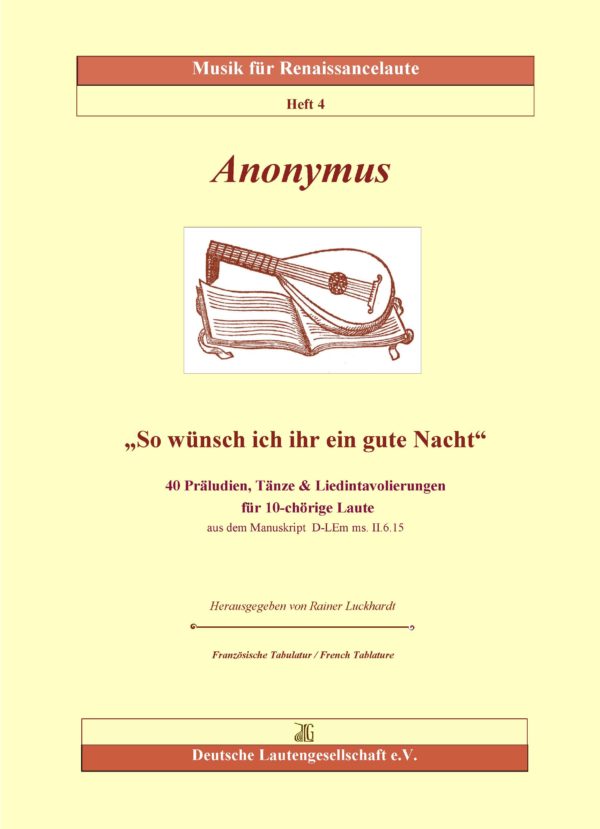
|
This extensive lute manuscript in German tablature (until recently wrongly attributed in the relevant publications to the Polish court lutenist Albert/Wojciech Dlugoraj) contains no less than 541 pages of around 600 pieces for Renaissance lute (six to eleven choruses). |
DLG 1400 | 18,- 14,40 (DLG member) |
Hans Gerle: Musica Teusch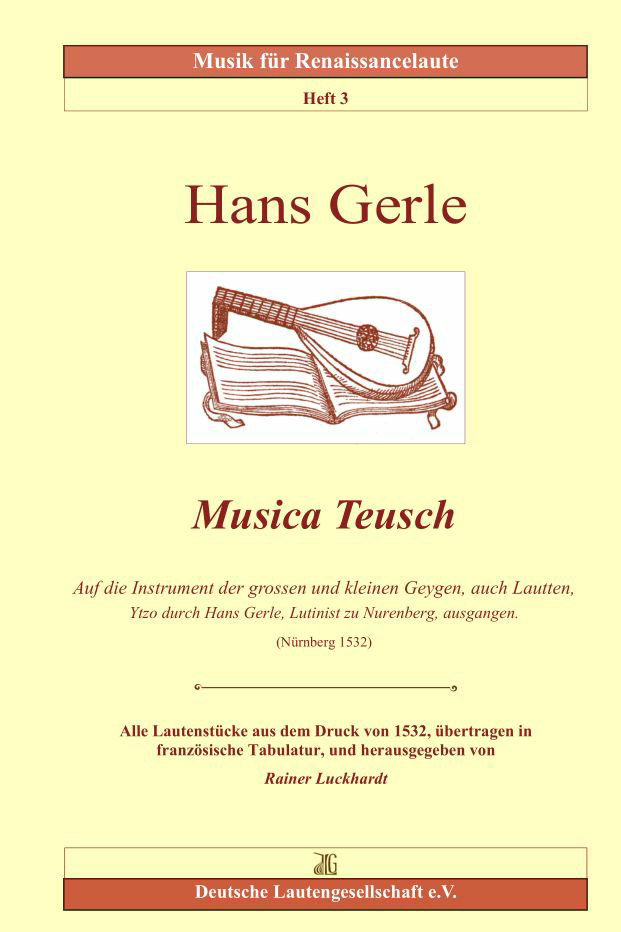
|
Complete edition of the lute music from Hans Gerle’s publication ‘Musica Teusch’ (Nuremberg 1532). One of the first printed tutors for the ‘small and large fiddle’ (violin/rebec and viola da gamba) as well as for the lute. All pieces for the 6- & 7-course lute are included in this edition. Transcribed from German into French tablature and edited by Rainer Luckhardt. With his tutor of 1532, Hans Gerle had published the second printed textbook for the lute, following Hans Judenkünig and four years before Hans Newsiedler. It contains 21 pieces for renaissance lute, comprising 19 vocal intabulations and two preludes. The 2-, 3- and 4-voiced intabulations are derived from vocal pieces by known contemporary composers, such as, for example, Ludwig Senfl, Paul Hofheimer, and Stefan Mahu. The repertoire is almost completely German, except for the last piece which is based on a chanson by Pierre de la Rue. Apparently, Gerle was much less Francophile than his fellow Nuremberg citizen Newsiedler, whose lute book (1536) includes many French pieces. In his lute books Gerle presents himself as a skilled arranger of lute intabulations, rather than as a composer. Neither of the two preludes originate from his pen, they bear much resemblance to preludes by Hans Judenkünig. A distinctive feature is demonstrated in the last three pieces, which have been arranged for a 7-course lute. |
DLG 1340 | 12,- 9,60 (DLG member) |
54 pieces for 6-course lute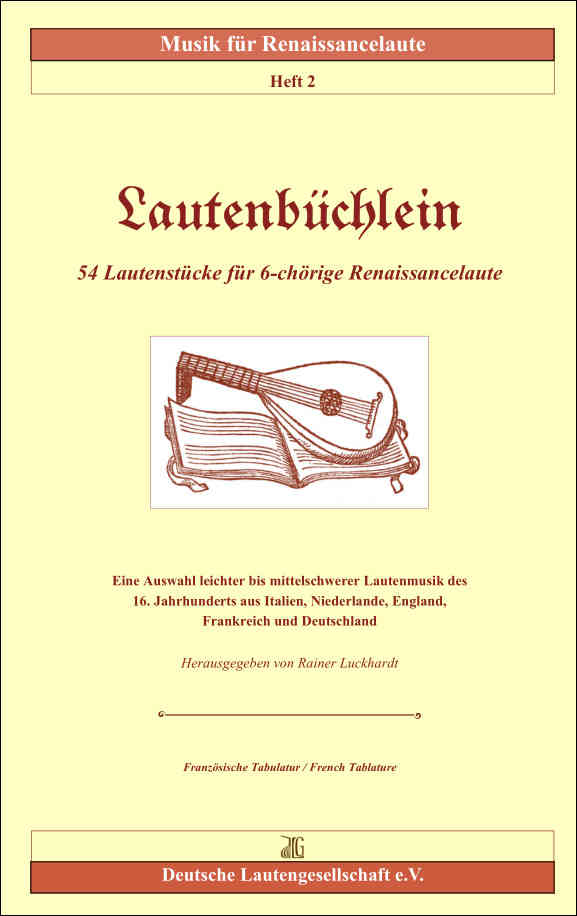
|
Just published by the German Lute Society Volume 2 of “Music for Renaissance Lute” includes 54 easy-to-intermediate pieces for 6-course lute from 16 th century Italy, Holland, England, France and Germany. The music has been chosen from different lesser-known sources such as: the Cavalcanti Ms., Thysius Ms., Ballet lute book,as well as prints by Attaignant, Le Roy and H. Newsidler. It’s not a scholarly edition but rather an entertaining book for beginners and moderately-advanced players, who (hopefully) will feel inspired to play its dances, song arrangements and ricercars with pleasure, to choose their own favorite pieces, and to meet along the way the different styles of Italian, Dutch, English, French and German lute music from the 16 th century. 37 bound pages, all in French tablature |
DLG 1320 | 15,- 12,- (DLG member) |
55 French chansons and dances for renaissance lute.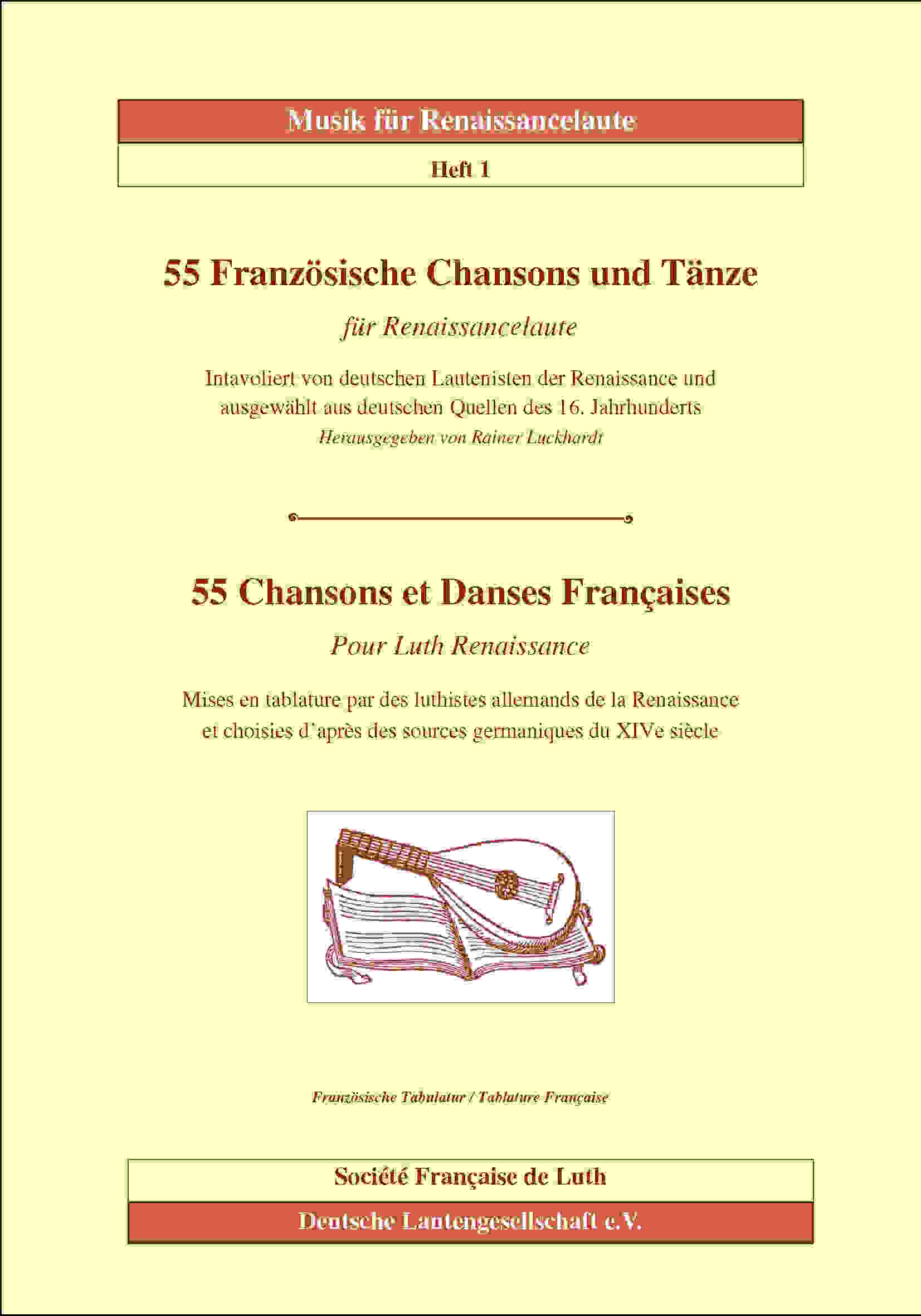
|
New edition by the DLG/SFL At the lute festival in Füssen, the first publication of the German Lute Society (DLG) for renaissance lute (in cooperation with the Société Française de Luth, SFL) was launched. The selection of pieces in this collection is restricted to works that do not present too many technical and musical challenges, and in which it appears that they have in some way passed through German ears, brains and fingers; that is they exhibit significant stylistic differences to the intabulations by French lutenists (such as Le Roy, Morlaye, Phalèse) It contains 55 chanson intabulations and dances from French sources that were arranged by German lutenists of the renaissance. Many of the arrangements are originally by Hans Newsidler and Wolff Heckel, for whom French music was evidently particularly attractive. Other anonymous tablatures originate from various manuscripts (for example Munich, Donauschlingen, Basel, etc). Most of the pieces were originally in German tablature, just a few were in French or Italian tablature. In this edition, all pieces are transcribed into French tablature. 67 pages. Edited and published by Rainer Luckhardt. |
DLG 1300 | 18,- 14,40 (DLG member) |
Works for baroque lute, mandora and baroque guitar.
| Title | Description | Order no. | Euro |
|---|---|---|---|
IL PRIMO LIBRO DELLE SONATE DI CHITTARA SPAGNOLA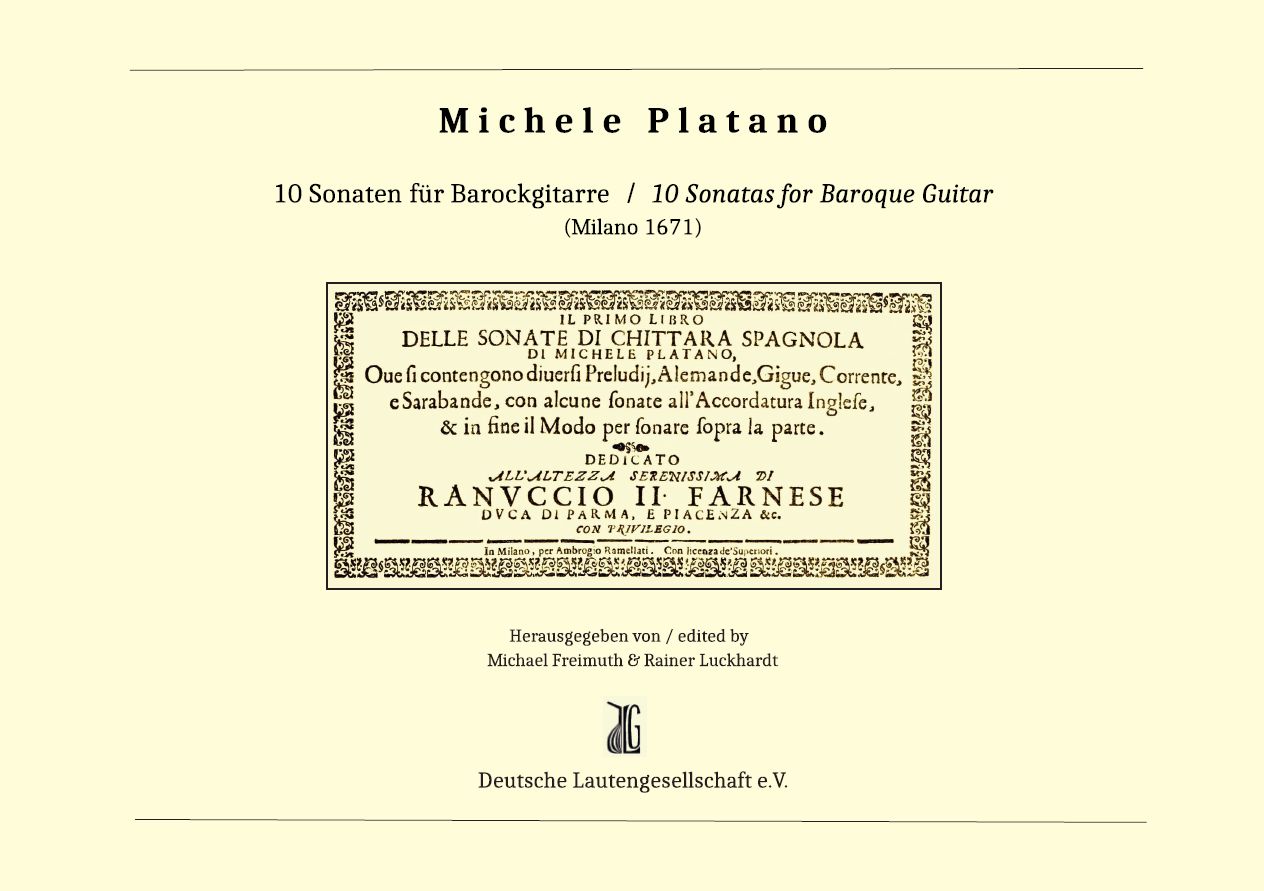
|
Recently published by the German Lute Society The print „IL PRIMO LIBRO DELLE SONATE DI CHITTARA SPAGNOLA “ (Milano, 1671) by Michele Platano contains 10 sonatas for baroque guitar, which recently has been discovered by Michael Freimuth at the austrian Staatsarchiv (Vienna). Michele Platano as well as his „Libro Primo“ were completely unknown to musicians and scholars until now. The music is pleasing and not to difficult to play. Eight sonatas are written in standard guitar tuning, two sonatas ask for scordaturas. Most of the single pieces are unique and without concordances in other manuscripts or printings. This new edition of Platano’s „Libro Primo“ is certainly welcome as an enrichement of the musical repertoire for baroque guitar. |
DLG 1360 | 21,- 16,80 (DLG member) |
Brian Wright: Fünf Variationen & Fuge über „Kein schöner Land“ 
|
The English lutenist and composer Brian Wright wrote this work in 2020 in two versions: Both versions are included in this edition. Everything, Theme, Variations and Fugue, are of medium difficulty, set sonorously and variedly, making use of the whole fingerboard. |
DLG 1350 | 12,- 9,60 (DLG member) |
The Kalivoda manuscript. D-Fschneider Ms 33. Music for baroque lute and mandora from Prague.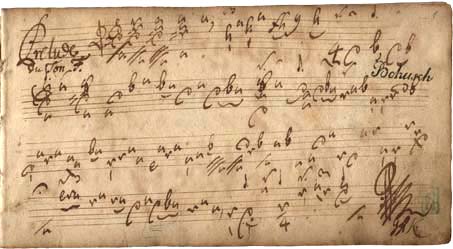
|
Colour facsimile of Ms 33 from the private library of Matthias Schneider (Frankfurt/Main). With introductory texts and a critical commentary (German and English). Ms 33 contains 35 pieces for 11-course baroque lute (some of them in parts) and a suite in three movements for 6-course mandora. It was written by the lutenist Georg Adalbert Kalivoda and was probably intended for an enthusiast. Previous owners include Alfred Cortot and Robert Spencer, and at a time before the second world war this lute book was probably in the hands of the musical researcher Paul Nettl. Nettl had also owned two other lute books, both of which today are in American libraries. 184 pages, with thread stitching, linen cover, header bands and bookmarks. Full-colour facsimile of the 66 handwritten pages and cover in the original format. Edited by Matthias O. Schneider, with contributions from Miloslav Študent (biography of Kalivodas), Mathias Rösel (on the music), Joachim Lüdtke (history from written records and analysis of the handwriting), also incipits and concordances by Markus Lutz. |
DLG 1280 | OUT OF PRINT! |
| The Rosani manuscript | (Music library of the City of Leipzig, Ms III.11.64) was created in the last quarter of the 18th century. 68 pages, preface, comments and concordances by Thomas Schall, with an introduction by Joachim Domning (1999). The facsimile edition contains: Partita I in F major (anonymous / Blohm?), Partita II in d minor (anonymous), 7 lute accompaniments from “Prof. Gellert’s Odes and Songs” (1760), Partita IV in F major (J. Kropffgans), Sonata I (anonymous), Sonata II (anonymous), Concerto in d minor (J. Kropffgans), Concerto in C major (J. Kropffgans), 2 Arias by J. A. Hasse, Concerto in Bb major (A. Falckenhagen), Partie in G major (J. Kropffgans), Partie XII in G major (J. Kropffgans).) |
DLG 1040 | 10,- 8,- (DLG member) |
| "Pieces choisies pour le Lut" |
University library Rostock, Mus Saec. XVIII 65. 6a-z; edited by Joachim Domning (1999). The lute book of the Duchess Louise of Mecklenburg (born 1722 as the daughter of the hereditary Prince of Württemberg; married from 1746 to the hereditary Prince of Mecklenburg) was assembled in Stuttgart as well as in Mecklenburg. It contains compositions for the baroque lute of varying difficulty and with differing musical demands. The collection comprises, amongst others, pieces by S. L. Weiss, Falckenhagen, Lauffensteiner, Count Bergen and compositions by P. Pichler. |
DLG 1020 | OUT OF PRINT! |
| Facsimile of the Rostock Lute Book Mus. Saec. XVII.18.-52.2 | Edited by Markus Lutz. The manuscript Rostock Mus. Saec. XVII.18.-52.2 is part of one of the most substantial of the collections of lute tablature originating in the baroque period. The collection of tablatures belongs almost completely to the substantial music collection of Luise Friederike of Mecklenbug-Schwerin, former Princess of Württemberg (03.02.1722 - 02.08.1791). More than a few of the manuscripts included in this collection originate from the music library of her father, the hereditary Prince Friedrich Ludwig of Württemberg (14.12.1698 – 23.11.1731). A complete facsimile edition of the lute book (in total 90 folios) is offered, with a detailed preface by Markus Lutz together with an index of concordances. The edition comprises a total of 220 pages. The volume contains 18 suites in total, as well as 2 partial suites and a few individual pieces for baroque lute in d-minor tuning of moderate difficulty, notated in French tablature. One of the partial suites (3rd movement) is a baroque lute duet. Most of the works appear to originate from the Austria-Bohemia region. Losy, Weichenberger and Lichtensteiger are among the composers, along with contemporary pieces by Gallot, Weiss and possibly Handel. |
DLG 1030 | 55,- 44,- (DLG member) (Spiral binding) 53,- 42,40 (DLG member) (Padded) |
| “Fundamenta der Lauten Musique und zugleich der Composition” | Edited by Rainer Luckhardt and Matthias Rösel. New edition of the Prague manuscript Ms. KK 51, 41 pages, text in Latin with German and English translations, many musical examples. The manuscript explains how to play basso continuo on the baroque lute, along with many examples. It begins with an explanation of pitch registers and their different scales. This is followed by simple triads and their inversions, and further figurings (e.g. sixth and seventh chords with inversions). A realisation in tablature corresponding to a figured bass is included. Several examples are worked out as short preludes in various keys. |
DLG 1050 | 15,- 12,- (DLG member) |
| FRANCESCO CORBETTA [Guitarra espanola y sus diferencias de sones], (ca. 1660) | Facsimile edition of the only known copy by the German Lute Society e.V. Editor: Matthias O. Schneider. Taken from a recently discovered source in a private collection (DFschneider Mus73), this comprises an extended version of Corbetta’s fourth guitar book ‘Varii Scherzi di Sonate per la Chitara Spagnola (1648)‘. In addition to the pieces in the original edition including preludes, toccatas, passacaglias, folias, allemandes, correntes, chaconnes and sarabands, the collection contains additional pieces by Corbetta, additional folia variations, and some Spanish pieces. Nicolas Antonio, Spanish bibliographer of the 17th century, mentions a book dedicated to the Spanish king Philip IV with the title ‘Gitarra espanolas y sus diferencias de sones‘ by Franciscus Corbera. In all probability, this edition covers the ‘hispanicised’ pirated copy, that only lacks a title page and dedication. Facsimile edition (Landscape format, paperback, 84 pages, Italian tablature with alfabeto) |
DLG 1010 | 35,- 28,- (DLG member) |
| Lute tablatures from Schloss Rohrau (Ms. Harrach) | Facsimile edition from the Schloss Rohrau residence of the Harrach family, consisting of two volumes of lute tablature. The first volume contains mainly works by Sylvius Leopold Weiss, including 11 suites of several movements that were hitherto unknown, and also a complete duet for two lutes in four movements and the Suite in A, hitherto known as a lute solo in a trio composition with violin and bass. The title of the second volume “Lute Music by Unknown Composers” apparently arose in ignorance that the music could be attributed by concordances to four suites by Weiss. Additionally there are a few suites in a style very close to that of Weiss. The volume also contains, somewhat surprisingly, four pieces in Italian tablature for renaissance tuning. The volumes, of 200 pages, taken along with the two known Weiss manuscripts in London and Dresden, close a gap in the sources of Weiss’s lute music, since they include mainly pieces from the earlier period of composition. In total, the two manuscripts from Rohrau contain 167 movements for lute, arranged in 26 suite-like sets. Both volumes in a single facsimile edition with extensive musicological commentary with thread stitching and a cloth cover. |
DLG 1210 | 150,- 120,- (DLG member) |
New compositions for lute
| Title | Description | Order no. | Euro |
|---|---|---|---|
| Peter Croton: Open house. Songs for Voice and Renaissance Lute or Guitar. "Midnight Fantasia" for Lute solo |
The 5 songs are notated in both French tablature and a transcription for guitar. The arrangement is for a 10-course instrument. Content: |
DLG 1080 | 13,- 10,40 (DLG member) |
| Dieter Krickeberg: ‘Consonants’. Duet for renaissance and baroque lute (1998/9). | The piece for renaissance and baroque lute comprises two movements, and is notated in two staves with treble and bass clef – no tablature! The composer says of his duet: “My compositions for early instruments include mostly elements of historic music …. In ‘Consonants’ the traditional feature is given in the 1st movement, corresponding to the title, with the dominant seventh forming a kind of pedal point. In the second movement, fragments of the motet ‘Domine non sum dignus’ by Tomás Luis de Victoria are used. In the combination with quarter-tones making up the final composition, I am naturally looking for new sounds.” |
DLG 1060 | 10,- 8,- (DLG member) |
| Jean-Jacques Dünki: Véhicules. Eight duets for baroque lute and clavichord. | Véhicules are eight fragile, volatile representations of slides and transitions, composed in two tunings; a’ = 432Hz for the clavichord, and a’ = 415Hz for the lute. This is an interval of a third of a tone between the two instruments, which offers much by way of harmonic tension. |
DLG 1070 | 10,- 8,- (DLG member) |
| Hans-Jürg Meier: "horning" for lute, timpani and viola (1999) | “horning” is the Swiss German version of the high-German word “Hornung”, the term for February in the old calendar. As it probably was previously, just as today, February with its extensive snow: heavy snowfalls and avalanches, stands in contrast with the sweet poetic enchantment of the landscape. “hornig” doesn’t concern itself primarily with this winter scene. The piece derives its energy much more from the contrast between the violent and the sweet. This is expressed in an opening viola solo, and is then carried through in the trio with the lute and the timpani in different relationships….. The baroque lute part (13-courses, a = 415Hz) is predominantly notated in the bass clef. |
DLG 1090 | 15,- 12,- (DLG member) |
| Joachim Domning: Das Eselein - Le petit âne (the little donkey) | Published by the German Lute Society in collaboration with the French Lute Society. The music was selected and set in tablature by Beate Dittmann. Sophie Guigui translated the fairy tale into French. In the complete version of the popular fairy tale by the Grimm brothers, the theme of Parsifal is sketched out in a simpler form. A being appears in the world as an idiot, or here as a donkey, and is transformed during the course of the story into a person. Just as children starting out on music are given an incentive, with effort and patience, to achieve their goal. The many illustrations included in the tale allow it to be easily performed on stage and combined with music. According to what is available, it can be performed by a single musician speaking and playing, or with a number of performers working together. Working with children, the wardrobe for the characters can be made up with modest means. Since the melodies are also available in staff notation, players of other instruments can also participate; guitarists should be able to play the simpler movements from the tablature. Fun for the children and joy for the parents are guaranteed. |
DLG 1270 | 14,40 11,50 (DLG member) |
Miscellaneous publications
| Title | Description | Order no. | Euro |
|---|---|---|---|
John Griffiths & Sigrid Wirth (Hg.): Teaching & Studying the Lute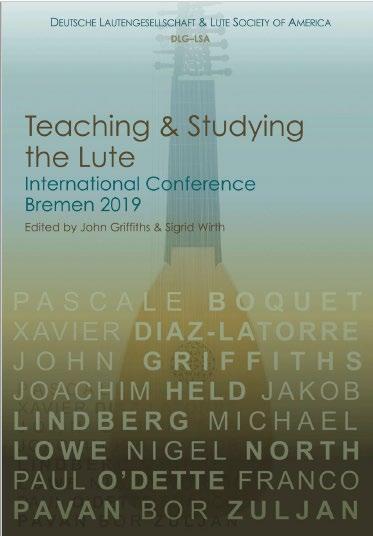
|
The papers presented at the "1st International Conference on Lute Study in Higher Education", which took place in Bremen from 27-29 September 2019, are now available in English as a joint publication of the DLG and the Lute Society of America as a paperback and e-book from AMAZON. Amazon 2021, 148 pages; Paperback: €16,08; Kindle edition: €7.53 |
Order at Amazon | |
Ingo Negwer: BACH and the LUTE. A critical study of the solo music for lute by Johann Sebastian Bach based on the sources.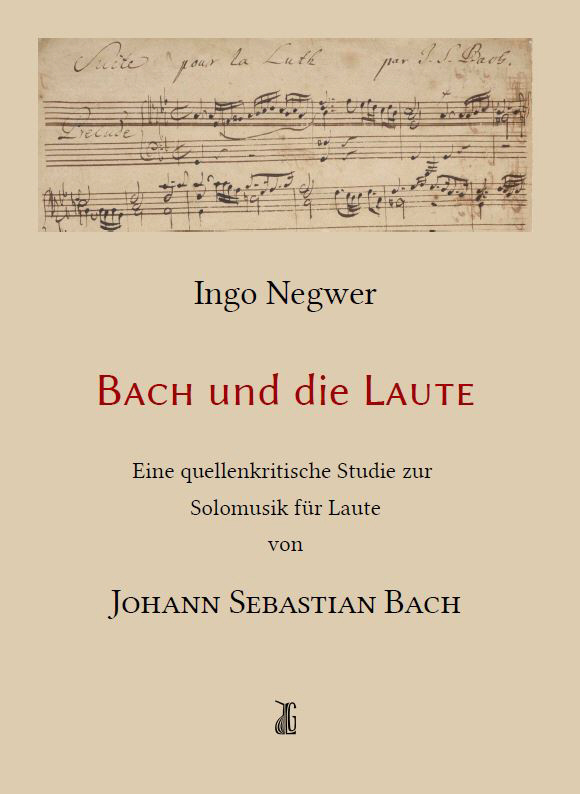
|
Alongside Silvius Leopold Weiss, Johann Sebastian Bach is a most significant creator of lute music in the 18th century. But which of his works (BWV 995-1000, 1006a) were really written by him for the lute? ‘Bach and the Lute’ approaches the question of the arrangement intended by the composer from a strictly music-historic perspective. Which compositions were clearly written for the lute? Which were adapted for the lute by other hands and possibly later on? Where do the sources that have passed down to us leave open the question of the arrangement that was originally intended ? With his book, Ingo Negwer would like to give new insights to those interested in Bach’s chamber music, in a small part of this large repertoire. Deutsche Lautengesellschaft, Frankfurt a.M. 2018 |
DLG 1310 | 19,- 15,20 (DLG member) |
| Ingo Newger: Lute and Theorbo in Marin Mersenne’s “Harmonie universelle” | In addition to a differentiated terminology for lutes with extended necks in the baroque period (theorbo, chitarrone, archlute), this book gives a fundamental insight into the performance practice of French music in the first half of the 17th century. It also gives a precise picture of the beginnings of basso continuo, and corrects the prevalent view of a delayed start to the period of the figured bass in France. As an appendix, the book presents a translation of the second volume (Livre second), that makes available completely, for the first time to the German-speaking public, Mersenne’s works on the plucked instruments. 218 pages, paperback |
DLG 1110 | 22,- 17,60 (DLG member) |
| The lute treatise of the Sloane Ms. 1021, British Museum (Stobaeus MS) | Facsimile and transcription of the instructions for lute-playing. Edited by Andreas Nachtsheim and the Lute Society (1996). |
DLG 1100 | OUT OF PRINT! |
| Werner von Strauch: Handbook of Tunings and Temperaments. | The Handbook of Tunings and Temperaments is a compendium of the experience of the author’s eighteen years of intensive practical and theoretical engagement with these musicological topics. Particular attention is given here to the frictionless combination of fretted and keyboard instruments, which is particularly reflected in the tables section. In a brief analysis, the various tunings and temperaments are illustrated and classified according to their characteristics. The fretted instruments are given detailed consideration in the following part. It is shown that the required gradations of the frets on the individual strings is the common case, with only one exception. Hard cover, 607 pages. | DLG 1200 | 68,00 54,40 (DLG member) |
